OWC Envoy Pro 1A
Support Manual

Introduction
1.1 System Requirements
Operating System & Hardware
- Works with any USB-C or USB-A equipped:
- Mac: macOS 10.13 or later
- PC: Windows 7 or later
- ChromeOS: current version recommended
NOTE: USB-C connection requires a USB-A to USB-C adapter (available separately)
Supported Drives
- Apple style PCIe (NVMe or AHCI) SSDs from select Mac systems and OWC Aura drives
- Mac Models:
- iMac (Late 2013 - Late 2019, excluding Late 2015)
- MacBook Air (Mid 2013 - 2017)
- MacBook Pro (Late 2013 - Early 2015)
- Mac Mini (Late 2014)
- Mac Pro (Late 2013)
- OWC Aura Drives: Aura Pro X2, Aura Pro X, Aura N2, & Aura N
- Mac Models:
1.2 Package Contents
- OWC Envoy Pro 1A
- USB Micro-B to Type-A cable
- Storage pouch
- OWC Envoy Pro 1A Getting Started QR Insert Card
- Thermal pad (with select solutions)
- Torx T5 Driver (with select solutions)
1.3 Overview
A. Enclosure LED - Solid White = Connection Established / Flashing White = Data Access (Read/Write)
B. USB 3.2 Gen 2 (10Gb/s) Micro-B Port

Getting Started
2.1 Device Setup
- This section describes the process of installing a drive into the OWC Envoy Pro 1A.
1. Place the OWC Envoy Pro 1A upside down on a flat static free surface. Remove the (2) case screws using a Torx T5 driver which will allow access to the inside of the enclosure.
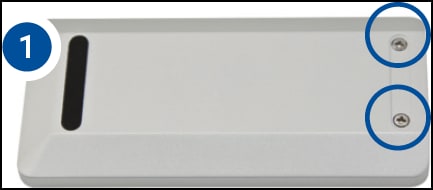
2. After the screws are removed, flip the enclosure over and lay it right-side up. Remove the cover by lifting up neat the LED and sliding it away from the USB port.

3. Carefully align the drive at a slight angle into the board connection and slide it forwards until fully seated.
4. Once the drive is fully seated use the included drive screw and Torx T5 driver to secure the drive.
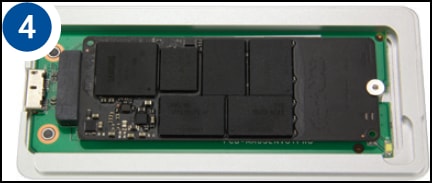
5. If the SSD does not have a heat sink, install the thermal pad on the inside of the cover. If you SSD has a pre-installed heat sink, no thermal pad is needed
- NOTE: The thermal pad corner should be aligned with a corner notch engraved on the inside of the cover. Positioning is important to ensure proper thermal dissipation.
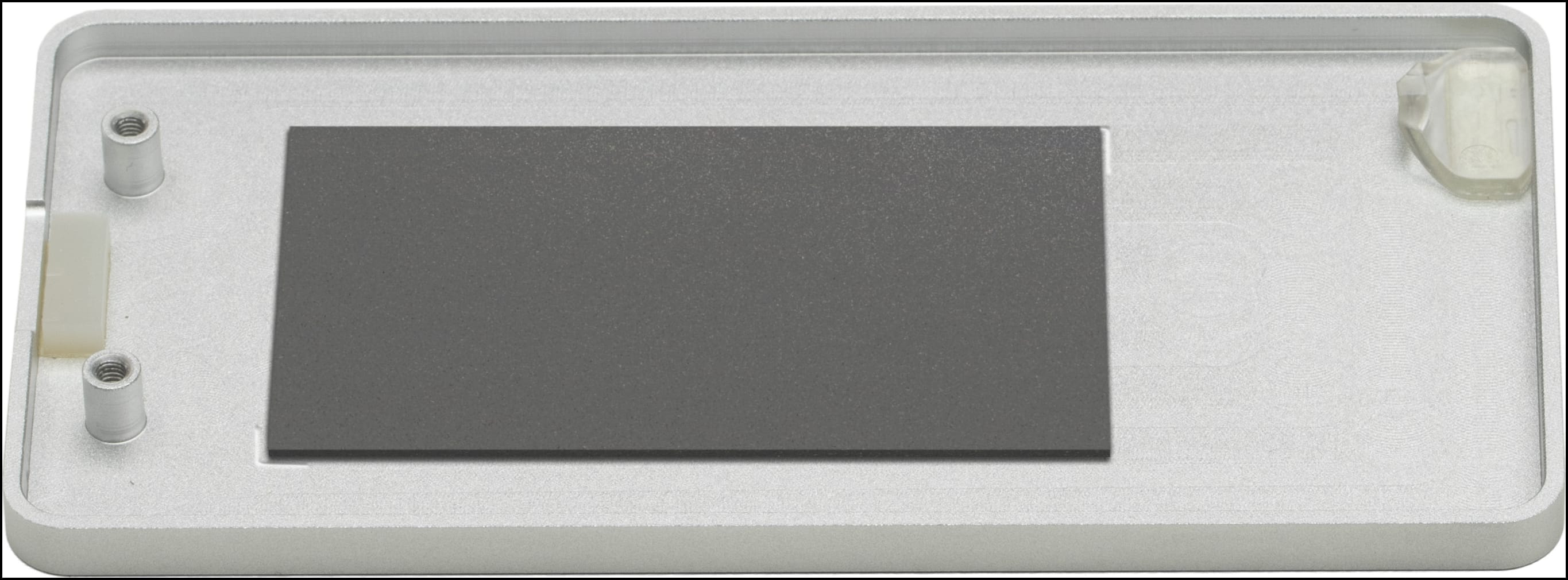
6. Place the cover back on the OWC Envoy Pro 1A starting with the LED side and laying down towards the USB port. Secure the cover using the (2) removed case screws form earlier using a Torx T5 driver.

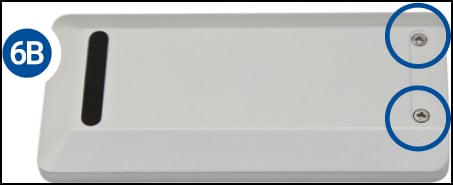
7. Once the case screws have been secured, add the included rubber foot in the notch housing the case screws.
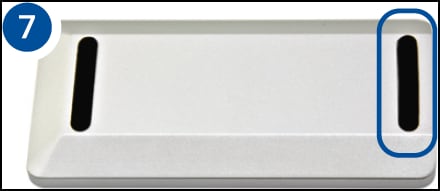
8. Connect the included USB cable into the OWC Envoy Pro 1A and into a compatible system. The LED will illuminate a solid white. The installed drive is ready to be formatted.
Device Management
3.1 Usage Notes
- The Envoy Pro 1A is designed to work with select Apple SSDs from most 2013 to 2019 Mac models. It is also compatible with Aura Pro X2, Aura Pro X, Aura N2, and Aura N drives. However, there are customers who own Aura X2 drives and other 3rd party drives with heatsinks. The heatsink doesn't allow for the Envoy Pro 1A cover to be applied because of the added height.
- Users can use the Envoy Pro 1A with drives that have a heatsink however, the cover will need to remain off. Prolonged Envoy Pro 1A use without the cover is not recommended due to debris exposure and potential fall damage.
- NOTE: Removing the heat sink to apply the Envoy Pro 1A cover is not supported and may void the drive manufacture warranty. Removal of the heat sink once applied to the Aura Pro X series of drives will void the warranty. Do not recommend or instruct for the removal of an applied heat sink.
- Users can use the Envoy Pro 1A with drives that have a heatsink however, the cover will need to remain off. Prolonged Envoy Pro 1A use without the cover is not recommended due to debris exposure and potential fall damage.
3.2 Manually Unmounting Volumes
- To ensure no data is lost during normal use, always eject or unmount the corresponding volume(s) from the operating system before powering off and disconnecting the device. Unmounting options are provided below.
macOS
- Drag the icon for the device you wish to unmount to the trash can; OR
- Right-click the device icon on the desktop, then click “Eject”; OR
- Highlight the device on your Desktop and press Command-E.
Windows
- Windows 10 build 1809 (October 2018) or later:
- Eject the drive by clicking the ‘Show hidden items’ menu in the Taskbar, then clicking ‘Safely Remove Hardware and Eject Media’, and last select the ‘Eject’ option for this volume.
- Windows 10 build 1803 and earlier:
- Go to the System Tray (located in the lower right corner of your screen). Click on the “Eject” icon (a small green arrow over a hardware image).
- A message will appear, detailing the devices that the “Eject” icon controls, i.e., “Safely remove...” Click on this prompt.
- You will then see a message that says, “Safe to Remove Hardware.” It is now safe to disconnect the device from the computer.
3.3 OWC Disk Performance
- As of Windows 10 v. 1809 the default Disk Removal Policy is ‘Quick removal’ instead of ‘Better performance’.
- NOTE: OWC storage solutions that are experiencing slow read/write speeds should consider checking and changing the Windows disk removal policy. Changing from "Quick removal" to "Better performance" can increase disk performance. OWC offers the application OWC Disk Performance to help change the Disk Removal Policy. Changing from "Quick removal" to "Better performance" can also be changed manually.
- Please review the support article Storage Solutions: OWC Disk Performance for more detail.
Support Resources
4.1 Troubleshooting
- Verify the USB cable is securely connected between the OWC Envoy Pro 1A and host.
- Connect the OWC Envoy Pro 1A and host with a different USB cable.
- Connect the OWC Envoy Pro 1A to a different host.
- Users experiencing slow read/write speeds should consider checking and changing the Windows disk removal policy. Please review the support article Storage Solutions: OWC Disk Performance for more detail.
- We are very sorry If issues continue to occur. Please know that OWC support is here to help. Contact information for our support can be found in section 4.4 "Contacting Support". Please have your serial number ready which is located on the bottom of the OWC Envoy Pro 1A and printed on the original packaging.
4.2 Online Resources
Support Articles:
Downloads:
Product Pages:
4.3 About Data Backup
- To ensure that your files are protected and to prevent data loss, we strongly suggest that you keep two copies of your data: one copy on your OWC Envoy Pro 1A and a second copy on either your internal drive or another storage medium, such as an optical backup, or on another external storage unit. Any data loss or corruption while using the OWC Envoy Pro 1A is the sole responsibility of the user, and under no circumstances may OWC, its parents, partners, affiliates, officers, employees, or agents be held liable for loss of the use of data including compensation of any kind or recovery of the data.
4.4 Contacting Support
4.5 About This Manual
- The images and descriptions may vary slightly between this manual and the unit shipped. Functions and features may change depending on the firmware version. The latest product details and warranty information can be found on the product web page. OWC’s Limited Warranty is not transferable and
General Use Precautions
- To avoid damage, do not expose the device to temperatures outside the following ranges:
- Environmental (Operating)
- Temperature (ºF): 41º — 95º
- Temperature (ºC): 5º — 35º
- Environmental (Non-Operating)
- Temperature (ºF): -4º — 140º
- Temperature (ºC): -20º — 60º
- Environmental (Operating)
- Always unplug the device from the electrical outlet if there is a risk of lightning or if it will be unused for an extended period-of-time. Otherwise, there is an increased risk of electrical shock, short-circuiting, or fire.
- Protect your device from excessive exposure to dust during use or storage. Dust can build up inside the device, increasing the risk of electrical shock, short-circuiting, or fire.
Safety Precautions
- Use proper anti-static precautions when handling this device. Failure to do so can increase the risk of electrical shock or short-circuiting.
- Never expose your device to rain, or use it near water, or in damp wet conditions. Never place objects containing liquids on the device, as they may spill everywhere and into the openings. This will increase the risk of electrical shock, short-circuiting, fire, or personal injury.
- To avoid any risk of electrical shock, short-circuiting, fire, or dangerous emissions, never insert any metallic object into the device.
- Please cease use of the device and contact OWC Support if it appears to be malfunctioning.
Terms & Conditions of Sale
Warranty
OWC’s products are subject to OWC’s Terms & Conditions of Sale located at Terms of Sale or other applicable terms. The OWC Envoy Pro 1A comes with a 1-Year Limited Warranty. Additional warranty information can be viewed by visiting Hardware Warranties.
Changes
The material in this document is for information purposes only and subject to change without notice. While reasonable efforts have been made in the preparation of this document to assure its accuracy, OWC, its parent, partners, affiliates, officers, employees, and agents assume no liability resulting from errors or omissions in this document, or from the use of the information contained herein. OWC reserves the right to make changes or revisions in the product design or the product manual without reservation and without obligation to notify any person of such revisions and changes.
FCC Statement
Warning! Modifications not authorized by the manufacturer may void the user’s authority to operate this device.
NOTE: This equipment has been tested and found to comply with the limits for a Class B digital device, pursuant to Part 15 of the FCC Rules. These limits are designed to provide reasonable protection against harmful interference in a residential installation. This equipment generates, uses and can radiate radio frequency energy and, if not installed and used in accordance with the instructions, may cause harmful interference to radio communications. However, there is no guarantee that interference will not occur in a particular installation. If this equipment does cause harmful interference with radio or television reception, which can be determined by turning the equipment off and on, the user is encouraged to try to correct the interference by one or more of the following measures:
- Reorient or relocate the receiving antenna.
- Increase the separation between the equipment and receiver.
- Connect the equipment to an outlet on a circuit different from that to which the receiver is connected.
Copyrights and Trademarks
© 2023 Other World Computing, Inc. All rights reserved. Envoy, OWC and the OWC logo are trademarks of New Concepts Development Corporation, registered in the U.S. and/or other countries. Mac and macOS are trademarks of Apple Inc., registered in the U.S. and other countries. Thunderbolt and the Thunderbolt logo are trademarks of Intel Corporation in the U.S. and/or other countries. Other marks may be the trademark or registered trademark property of their owners.
No part of this publication may be reproduced, stored in a retrieval system, or transmitted in any form or by any means, electronic, mechanical, photocopying, recording or otherwise, without the prior written consent of OWC.
Free Support Chat
Our free award-winning support team is ready to answer all of your questions. Technical support is available Monday - Friday: 9AM - 6PM. Customer Support & Sales is available Monday - Friday: 9AM - 6PM. Support is unavailable on U.S. Federal holidays. Talk to a human today.

 1-800-275-4576
1-800-275-4576